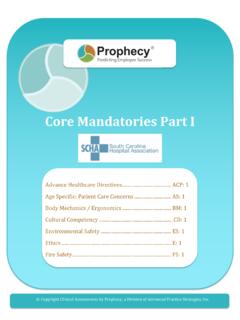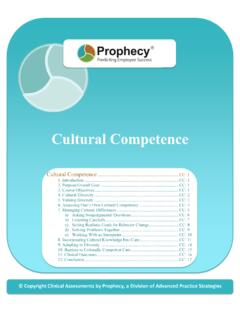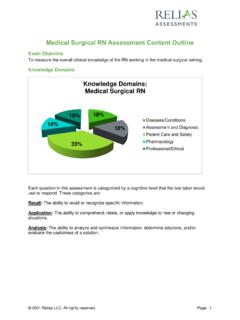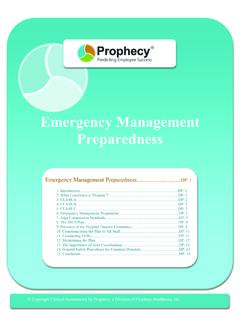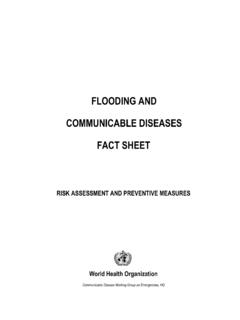Transcription of Infection Control/ Bloodborne Pathogens - Prophecy Health
1 Copyright Clinical Assessments by Prophecy , a Division of Advanced Practice Strategies Infection Control/ Bloodborne Pathogens Infection Control/ Bloodborne Pathogens .. IC: 1 1. Introduction .. IC: 1 2. Purpose/Overall Goal .. IC: 1 3. Course Objectives .. IC: 1 4. Hand Hygiene .. IC: 2 5. Gloves .. IC: 3 6. Gowns, Masks, Eye Protection .. IC: 4 7. Safe Injection Practices .. IC: 5 8. Respiratory Infections/Cough Etiquette .. IC: 6 9. Bloodborne Pathogens .. IC: 7 10. Hepatitis .. IC: 8 11. HIV/AIDS .. IC: 9 12. Transmission-Based Precautions .. IC: 10 13. Multidrug-Resistant Organisms (MDROs) .. IC: 12 14. Tuberculosis .. IC: 13 15. Ebola .. IC: 14 16. Handling and Disposal of Infectious Waste .. IC: 18 17. Conclusion .. IC: 19 IC: 1 Infection Control/ Bloodborne Pathogens INTRODUCTION Infectious diseases are caused by microscopic organisms that penetrate the body s natural barriers and multiply. They create symptoms that can range from mild to fatal. The Centers for Disease Control and Prevention (CDC), the world Health organization , and other agencies have established guidelines to help protect patients and healthcare workers from exposure to potential infections.
2 These guidelines establish policies for hand-washing, the use of Personal Protective Equipment (PPE), safe injection practices, cough etiquette, and more. Following Standard Precautions is a requirement, not an option. It will reduce your risk of cross contamination from infected patients to yourself and others, as well as from yourself to patients. Standard Precautions must be used for all patients, at all times, by all healthcare workers. PURPOSE/OVERALL GOAL This module outlines procedures for healthcare workers to avoid personal exposure to infections and Bloodborne Pathogens , and to keep infections from spreading to patients, visitors, and other workers. The goal of this module is to instruct you on how to stay safe from Infection as you go about your work at your facility. COURSE OBJECTIVES After completing this module, the learner should be able to: 1. Explain the importance of standard Infection -control precautions 2. Explain how to protect themselves and others from Infection 3.
3 Define Personal Protection Equipment and how to use it 4. Describe precautions to take for patients with serious infections 5. Describe how to handle and dispose of infectious waste IC: 2 HAND HYGIENE Hand-washing is considered the single most important procedure for preventing nosocomial (hospital - acquired) infections. Any healthcare worker involved in direct or indirect patient care must know how and when to perform proper hand hygiene. The world Health organization states that hands must always be properly washed: 1. Before patient contact 2. Before performing an aseptic procedure (a procedure that must be free from bacteria and other microorganisms) 3. After exposure to any body fluids 4. After patient contact 5. After contact with patient surroundings (touching items in the immediate patient care environment, even if you don t touch the patient) If your hands are not visibly soiled, you may use an alcohol-based rub: 1. Apply the product to the palm of one hand. 2. Rub your hands together, covering all surfaces of hands and fingers.
4 3. Rub until your hands are dry. If your hands are soiled, wash with soap and water following these procedures: 1. Wet your hands first with water. 2. Apply soap; liquid, bar, or powdered forms of plain soap are acceptable. 3. Rub your hands together vigorously for at least 15 seconds, covering all surfaces of your hands and fingers. 4. Rinse your hands with water and dry thoroughly with a disposable towel. 5. Use the towel to turn off the faucet. 6. Avoid using very hot water, since repeated exposure to hot water may increase the risk of dermatitis. If you use hand lotion: You should have your own container; shared bottles can easily become contaminated. Use only water-based products and only those that are hospital-approved. Just because a product washes off with water does not mean it is water-based. Using lanolin or oil-based lotions before donning gloves will seriously weaken the gloves, increasing the risk that germs will pass through the gloves. Fingernails: Numerous studies have been conducted on artificial nails, the nail hygiene of healthcare personnel, and the transmission of healthcare-associated infections to patients.
5 The Centers for Disease Control and Prevention (CDC) states that nail tips should be less than one-quarter inch long. The CDC and the world Health organization state that those who have direct contact with patients at high risk should not have artificial fingernails or extenders. IC: 3 GLOVES Personal Protective Equipment (PPE) is specialized clothing or equipment designed for your protection against Infection . Gloves are a type of PPE. Gloves MUST be worn when there is a possibility of contact with: 1. Blood and/or body fluids 2. Mucous membranes 3. Non-intact (broken) skin 4. Contact with contaminated items Keep these important facts in mind regarding gloves: Wear gloves that fit properly. Do not wear the same pair of gloves for the care of more than one patient. Do not wash gloves so that you can reuse them. Remove and/or change gloves after you complete your task and whenever the gloves become soiled or damaged. Turn the gloves inside out when removing them, and dispose of them in the proper receptacle.
6 Clean your hands before putting gloves on and also immediately after removing them. Never wear multiple layers of gloves in order to peel off layers between tasks. Always wear the right gloves for the job: o Wear heavy work gloves for cleaning. o Never wear latex gloves when caring for a patient with a latex allergy; instead, wear a synthetic glove such as vinyl. Latex Allergies Latex is contained in a variety of products such as gloves, catheters, adhesive bandages and tape, and more. It is also present in a variety of household items such as rubber bands, balloons, condoms, and dental dams. Allergic reactions to latex range from skin irritation and itching to life-threatening episodes of anaphylactic shock. It is the responsibility of healthcare workers to protect themselves, coworkers and patients from unnecessary exposure to latex. Some important points to remember about latex allergies: Ask patients questions about allergies, including latex allergies, in terms that they understand.
7 Document findings in the patient chart. All latex products, including gloves, MUST be kept away from allergic patients and staff. Latex products release latex allergens into the air, and these allergens may cause reactions in latex-allergic persons. Glove powder from latex gloves may carry enough latex allergen through the air to cause reactions in allergic persons. If you suspect that you have a latex allergy, contact Employee Health for an appointment to rule out this allergy. IC: 4 GOWNS, MASKS, EYE PROTECTION Other types of Personal Protective Equipment (PPE) include gowns, masks, and eye protection. Wear a gown that is appropriate to your task, to protect your skin and prevent soiling or contamination of your clothing during procedures or activities when you are likely to come in contact with blood, body fluids, excretions, or secretions. Do not wear the same gown for the care of more than one patient. Remove a soiled gown as soon as possible. Practice hand hygiene after removal of gown.
8 Wear a mask and eye protection or a face shield to protect the mucous membranes of your eyes, nose, and mouth during procedures or activities when you are likely to come in contact with blood, body fluids, excretions, or secretions. To protect your respiratory tract from airborne infectious agent such as tuberculosis (TB), use a respirator (commonly called the N95 mask ) when necessary. IC: 5 SAFE INJECTION PRACTICES According to the Centers for Disease Control and Prevention (CDC), improper use of syringes, needles, and medication vials during routine healthcare procedures have resulted in transmission of Bloodborne viruses such as hepatitis and human immunodeficiency virus (HIV). Recommendations by the CDC for safe injection practices include: Follow proper Infection control practices. Maintain Aseptic Technique when preparing and administering injected medications (follow hand-washing guidelines and maintain a sterile field). Never administer medications from the same syringe to more than one patient, even if the needle is changed.
9 Never enter a vial with a used syringe or needle. Do not use medications packaged as single-dose or single-use for more than one patient. Do not use bags of intravenous solution as a common source of supply for more than one patient. Limit the use of multi-dose vials and dedicate them to a single patient whenever possible. Always use facemasks when injected material or inserting a catheter into the epidural or subdural space. IC: 6 RESPIRATORY INFECTIONS/COUGH ETIQUETTE Coughs and sneezes produce droplets that can be inhaled by people nearby, spreading viruses. Following simple cough etiquette procedures can help protect you as a healthcare worker as well as patients and visitors at your facility. Cover your mouth and nose when you cough or sneeze, with a tissue if at all possible. Throw used tissues away immediately. Use a surgical mask for patients who are coughing, if tolerated and appropriate. Use a surgical mask yourself if you are coughing. Clean your hands after contact with respiratory secretions.
10 Stay at least three feet away, if possible, from people with respiratory infections. IC: 7 Bloodborne Pathogens Bloodborne Pathogens are infectious microorganisms in human blood that can cause disease. Examples are hepatitis B (HBV), hepatitis C (HCV), and human immunodeficiency virus (HIV, the virus that causes AIDS). Healthcare workers are at risk for exposure through needle sticks or other sharps related injuries. All used sharps are considered contaminated. It is essential to follow these guidelines: Never bend or break needles and other used sharps after use. Never recap contaminated needles. Always use needle-based safety devices when available. Never carry a used sharp in a pocket. Dispose of sharps in designated sharps disposal containers. Sharps disposal containers should be sealed and removed when three-quarters full to avoid overflow. Do not attempt to remove anything from a sharps disposal container. Properly dispose of all sharp objects, such as syringes with needles and scalpels, after use.
